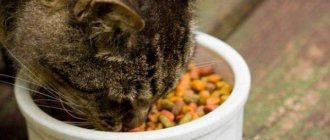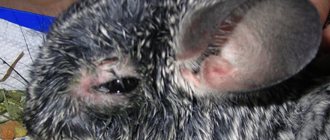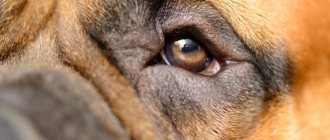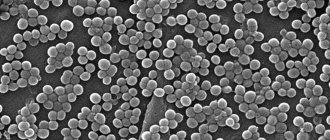Kidney disease is most often reported in older cats. The organ maintains the acid-base balance in the blood, secretes hormones, and produces urine.
Kidney tissue is not capable of recovery, and clinical symptoms appear when more than 2/3 of the organ fails.
The main task of the cat owner and veterinarian is to stop the increase in destructive processes and prolong the life of the pet while feeling satisfactory. This publication tells you how to do this.
Factors influencing the development of kidney disease in cats
Many factors influence the functioning of the excretory organs.
The unfavorable ones include the following:
- Unsatisfactory nutrition: protein overfeeding, imbalance in vitamins and minerals, consumption of food unusual for cats, containing spices, sugar, table salt, and also smoked or fried.
- Unfavorable living conditions: drafts, dampness, dirty tray.
- Viral and bacterial infections.
- Chronic diseases: cystitis, urolithiasis, pancreatitis; hepatitis, diabetes mellitus, gingivitis, pyometra.
- Poisoning with toxic substances or medications.
- Worm infestation.
- Allergy.
- Poor water quality.
- Genetic abnormalities. They end up dying at an early age.
- Predisposition to kidney disease in certain breeds.
Common feline kidney diseases
Inflammatory kidney diseases are called nephritis.
The most common types that develop in cats are:
- Pyelonephritis - purulent processes in the parenchyma and pelvis under the influence of pathogenic bacteria;
- Nephrosclerosis : replacement of parenchyma with connective tissue.
- Hydronephrosis : expansion of the pelvis, in which urine is retained and compresses the parenchyma, which eventually atrophies;
- Chronic renal failure (CRF). In which the organ ceases to perform its functions;
- Glomerulonephritis: non-infectious damage to the filtering glomeruli;
- Polycystic disease is the congenital presence of empty cavities in the parenchyma that are constantly increasing;
- Amyloidosis is a genetic abnormality characterized by the replacement of parenchyma with starch-like substances (amylum).
Be sure to read:
Polycystic kidney disease in cats: causes, symptoms, treatment, how long they live with this disease, prevention
Nephritis can occur in acute and chronic form with periodic exacerbations.
Common kidney pathologies
Kidney pathologies in cats occur in most cases due to the development of infectious microflora. Any disease arises from an acute stage and, without timely treatment, becomes chronic, characterized by frequent relapses. Kidney diseases commonly diagnosed in cats are:
- Amyloidosis is a pathology in the kidneys caused by impaired metabolism. The disease is characterized by the deposition of a substance called amyloid in the kidney tissues. All breeds of cats are susceptible to the disease, but most often the disease is diagnosed in representatives of the Abyssinian and Somali breeds.
- Congenital pathologies – dysplasia and aplasia. Dysplasia is the abnormal development of an organ, aplasia is a congenital anomaly when an animal lacks one or two kidneys. Kittens born with one kidney have a chance for a full life. If the paired organ is missing, such kittens die immediately after birth.
- Nephritis - the disease has three subtypes - pyelonephritis, hydronephritis and glomeronephritis. Nephritis is characterized by the development of an inflammatory process in the kidneys, which is provoked by the entry of infectious microflora into the urinary system. More often the disease occurs on one kidney. However, if the acute stage of primary infection is not quickly cured, the infectious-inflammatory process spreads to a second organ.
- Polycystic – this pathology is hereditary and cannot be treated. Polycystic kidney disease occurs mainly in Persian, Himalayan and other exotic breeds. Polycystic disease is characterized by the formation of small cavities on the tissues of the organ, which are filled with fluid. Polycystic disease is detected during diagnosis only in an adult cat. It is not possible to identify pathology in a kitten born with polycystic disease.
All kidney diseases are characterized by almost one nonspecific symptomatic picture. It is almost impossible to make a diagnosis only by analyzing the signs present in the animal.
Kidney disease in cats: symptoms
The following symptoms indicate kidney disease:
- Appetite decreases or the cat refuses food.
- The urine becomes cloudy and has an unpleasant odor. The test reveals protein, pus (pyuria) or blood (hematuria).
- Signs of intoxication increase, vomiting and diarrhea develop.
- The mucous membranes become bluish.
- Urination becomes painful. The pet arches its back and screams.
- If the outflow of urine is not impaired, polyuria develops - an increase in the volume of urine and the frequency of trips to the tray.
- If urination is difficult due to obstructions in the canals, a frequent urge to urinate is noted.
- The animal changes its habit of going to bed in a warm place. Prefers cold, which reduces pain.
Different types of diseases are characterized by the following additional symptoms:
- a creeping gait on half-bent legs, abdominal pain are characteristic of pyelonephritis;
- lumbar pain, fever, hematuria suggest glomerulonephritis.
Nephritis and nephrosis
Nephritis is a “simple” inflammation of the kidneys, while nephrosis is a complex inflammatory-degenerative process in them.
The reasons for the development are quite varied:
- Poisoning, including chronic. The latter are especially typical for cats that were fed stale waste from the refrigerator.
- Autoimmune diseases.
- Neglect of drug manufacturers' recommendations. Problems with the kidneys in cats especially often occur when they are “stuffed” with antibiotics and other antimicrobial agents for a long time. They have a detrimental effect on the condition of the kidneys and liver.
- Hereditary predisposition.
- Various infectious diseases. Pathologies of a viral nature are especially dangerous for the kidneys. The fact is that viruses, which are intracellular parasites, destroy nephrons, as a result of which inflammation develops, and the performance of the kidneys greatly deteriorates.
Symptoms
In case of nephritis with nephrosis, it does not shine with particular variety (compared to other kidney diseases), but there are still certain nuances:
- Polydipsia, polyuria, vomiting and other characteristic signs.
- With deep palpation in the kidney area, the cat meows loudly and hoarsely, scratches, and expresses its displeasure in other ways. The reason is simple - he’s just in pain.
- In addition, with many types of jade, the overall body temperature increases.
- These kidney diseases in cats are characterized by severe anemia.
- Also, with these ailments, blood pressure rises sharply, which is fraught with the development of many eye diseases, including glaucoma.
Of course, in such conditions the animal becomes lethargic and refuses food. Urine (especially with purulent inflammation and necrotic nephritis) can emit a clearly noticeable and extremely unpleasant odor.
Treatment
They are not particularly diverse, but vary depending on the root cause of the disease. Thus, for infections, broad-spectrum antibiotics are prescribed (while avoiding tetracycline drugs), poisoning is treated by administering appropriate antidotes (if the type of poison is known) and intravenous infusion of compounds to relieve intoxication. Since anemia is common in nephritis with nephrosis, erythropoietin is prescribed to sick animals. You need to feed your cat nutritious, easily digestible food. If there is protein in the urine, there should be a slight excess of it in the food (to compensate for losses).
Diagnosis of kidney problems in cats
Based on clinical symptoms, the owner may suspect that the cat has kidney pain, but only a specialist can determine the type of disease. The veterinarian collects anamnesis and prescribes a general urine test.
If necessary, blood is examined for creatinine and the ratio of serum protein fractions, and an ultrasound is also performed. Bacteriological culture identifies the causative agent of infection, as well as its sensitivity to antibiotics.
Cat kidneys
The kidneys perform the following important functions:
- excrete water-soluble metabolic products in urine;
- regulate the volume and composition of fluid in the body;
- responsible for endocrine functions (formation of erythropoietin, angiotensin II and calcitriol).
Kidneys are paired oval-shaped organs located in the abdominal cavity.
They are attached using long ligaments, which allows them to change position. Therefore, it is impossible to feel the kidneys in cats in the same place (this can only be done by an experienced veterinarian). Cat kidneys are organs of dense consistency, smooth, single-papillary, bean-shaped, yellowish-red in color, light or dark. In a cat, both kidneys have approximately the same mass. With increasing age, the mass of the kidneys also increases.
The kidneys are located on either side of the median plane under the dorsal abdominal wall. The posterior vena cava passes near the gate of the right kidney, and the abdominal aorta passes near the gate of the left kidney. From these two vessels depart the left and right renal arteries and veins (renal artery and vein).
The kidneys have three membranes: fibrous, fatty and serous.
On the outside, the kidney is covered with a rather dense fibrous capsule (capsula renalis fibrosa), which loosely connects to the kidney parenchyma and, wrapping itself inside the organ, is attached to the renal pelvis. On the surface, the fibrous capsule is surrounded by a fatty membrane (capsula adiposa). On the ventral surface, the kidney is also covered with a serous membrane (peritoneum).
In overweight cats, these organs are additionally protected by an elastic sheath of adipose tissue. Nerves and blood vessels enter the center of the inner cavity of the kidney, and the ureter emerges.
KIDNEY STRUCTURE
On the surface of the organ there is a dark cortical zone (kortex renis) with a thickness of 2-5 mm, in the center there is a lighter cerebral zone.
In shape it resembles a pyramid (pyramides renalis), the apex of which is formed by one renal papilla (papilla renalis). The medulla of the kidney (medulla renis) is divided into two zones. The outer zone (zona externa), dark red in color, contains, along with the collecting ducts, thickened parts of the nephron loop.
The inner zone, (zona interna), is yellowish-white in color and contains the thin parts of the nephron loop and collecting ducts.
Between these zones in the form of a dark stripe there is an intermediate zone (zona intermedia), where there are arcuate arteries, from which interlobular arteries are separated towards the cortical zone, along which are located renal corpuscles, consisting of a glomerulus - the glomerulus glomerulus (choroid glomerulus), which is formed by the capillaries of the afferent arteries and capsules (capsula glomeruli).
The renal corpuscle, together with the convoluted tubule and its vessels, makes up the structural and functional unit of the kidney - the nephron.
In the renal corpuscle, primary urine is filtered from the blood coming from the vessels, after which processed water and useful substances enter the blood through the same channel. The remaining fluid after filtration is sent to the renal pelvis (pelvis renalis), from where secondary urine is removed through the ureter (ureter).
Kidney disease in cats: treatment
The specialist deciphers the test results and develops a method for treating the disease. Before starting drug treatment, the keeping and feeding of the cat is brought into compliance with zoohygienic standards.
The animal is kept dry, warm and free of drafts. Transfer to daily drinking with bottled water, which is changed daily. Treats from the table and store-bought treats are cancelled.
Medications
Medicines are prescribed by a veterinarian based on the diagnosis. Treatment is aimed at eliminating acute symptoms of the disease. If pathogenic bacteria are detected, antibiotic therapy is carried out. Treatment begins with first-choice drugs. After receiving the results of the antibiotic sensitivity test, treatment is adjusted.
Be sure to read:
Ketosteril for cats: instructions for use, price, reviews, analogues
Additionally, symptomatic drugs are administered that normalize the functioning of the raw material, liver, and digestive organs. If an allergic cause of kidney disease is established, immunosuppressants are used.
When the acute symptoms of the disease are relieved, maintenance therapy is prescribed to prevent relapses. In most cases, we are talking about lifelong treatment that maintains the pet’s satisfactory well-being.
Change of diet, diet
An important component during treatment and rehabilitation is dietary nutrition. Diseased kidneys are unable to remove toxic waste produced during the digestive process. In most cases, it was precisely such substances that slowly poisoned the kidney tissue until they disabled most of the parenchyma.
For the duration of treatment, veterinary food is selected, which is low in protein, sodium, magnesium, phosphorus, high in calories, and high in unsaturated fatty acids Omega 3; 6 in the optimal ratio. The completeness of protein nutrition at low protein levels should be ensured through the addition of synthetic analogues of essential amino acids - methionine, taurine, carnitine.
You will have to give up natural food, since it is impossible to create a diet, purchase a set of feeds that meets the requirements, and control the content of nutrients in them at home.
Hill's k/d food is popular among veterinary feeds. It is produced in the form of dry granules, wet canned food in jars and soft packaging - spiders.
While symptoms of acute illness are present, dry food is discontinued. The cat's appetite is poor, and it will eat wet canned food more readily. It should be borne in mind that an open can of canned food must be stored in the refrigerator for no more than 36 hours.
After stopping acute processes, you can switch to more convenient and economical dry granules. If the pet feels satisfactory, therapeutic food is prescribed for lifelong use.
Diagnostics
Renal failure in cats can be reliably diagnosed if clinically possible. For diagnosis, you need to take a urine and blood test and undergo an ultrasound.
Laboratory studies are indicative. Blood biochemistry will reveal increased levels of creatinine, urea and other components, but calcium, on the contrary, will be reduced and acidity increased.
If this is acute renal failure, then a urine test will reveal protein and the presence of dead renal epithelium, glucose, and red blood cells. With chronic renal failure, urine will have a low specific gravity and density, protein will be very difficult to determine, but dystrophic cells of the tubular epithelium will be noticeable.
The results of a general blood test in the acute form will not show any peculiarities, but in the chronic form, anemia and an increased number of ESR will be revealed.
An ultrasound of the kidneys will show a changed structure of the organ, stones and tumors. If the form of the disease is acute, then the kidneys will be enlarged with edema, and in the chronic case, on the contrary, a strong decrease in the size of the organs and an uneven and clear contour will be shown.
It happens that a veterinarian suggests examining a pet for possible kidney problems even though there seem to be none. You shouldn’t refuse, because you can detect problems at an early stage, which significantly simplifies the situation and gives many chances for a cure.
global $ads_google; //data-ad-slot=”2475549904″ $ads_google = empty($ads_google) ? false : true; ?> if ($ads_google == false) {?>
$ads_google = true; ?> } ?>
At home, an accurate diagnosis cannot be made based only on symptoms.
Prevention of kidney disease in cats
Prevention of kidney disease involves ensuring proper housing and feeding conditions. For sleeping, cats are provided with a rookery or bedding; there should be no dampness or drafts in the room.
Be sure to read:
Tripelphosphates and struvites in the urine of a cat: what is it, normal and abnormalities, reasons for the increase, treatment
Cats do not tolerate heat well, so you should use an air conditioner, but so that the flow of cold air from your device does not hit your pet. Animals are dewormed and vaccinated quarterly in accordance with the vaccination plan. Protects against fleas, which can cause an allergic response and trigger a pathological process.
Provide adequate nutrition taking into account age and physiological state. They use ready-made feed of at least premium class or a feed mixture of similar quality from natural products. Particular attention should be paid to the quality of drinking. Often the cause of struvite formation and the development of urolithiasis is hard tap water. The best option is to use bottled liquid for drinking.
To prevent stagnation of urine, they protect pets from obesity and organize active games. To be sure that your cat is healthy, you need to conduct examinations 2 times a year.
Treatment of cat kidney failure
Since the condition of a cat with acute renal failure is different from the condition with chronic renal failure, the treatment processes will be different.
The most common sense decision if you suspect kidney failure in cats is to visit a veterinarian. Do not ignore the advice of a veterinarian:
If we are talking about an acute form, then intensive therapy will be carried out to remove toxins and combat dehydration.
If a chronic form is detected with damage to two-thirds of the kidneys, then treatment is prescribed only by a specialist.
Hospital treatment is prescribed for acute renal failure, as it is life-threatening. The process is designed for 10-14 days. Veterinarians will eliminate the main cause of the disease. If this is a blockage of the outflow of urine by a stone, then it will be removed by a catheter.
After this, the underlying pathology will be treated with intravenous infusions, which will eliminate problems with water-salt metabolism and acidosis. At the same time, cardiac activity, which suffers from excess potassium, is maintained.
Diuresis is stimulated, and sometimes peritoneal dialysis is performed to remove toxins. The abdominal cavity and drainages are involved in this - this will significantly reduce the load on diseased kidneys.
With inpatient treatment, the result can be the most positive with complete preservation of the functionality of the organs, but it is not particularly rosy if the patient gets to the doctors late. In this case, the cat faces a chronic form of the disease. The chronic form is treated in a hospital during relapses or complications.
In case of severe damage, kidney transplantation is possible.
A therapeutic diet will be prescribed, which will need to be strictly followed throughout the pet’s life. Even with serious damage, you can extend your pet’s life by three years, while alleviating its condition.
At home
global $ads_google; //data-ad-slot=”2475549904″ $ads_google = empty($ads_google) ? false : true; ?> if ($ads_google == false) {?>
$ads_google = true; ?> } ?>
At home, you will need to maintain your body and kidney function in the best possible condition. You will need to study the recommended cat diet and create a strict diet where the phosphorus content is minimal.
Everything else is done strictly according to the veterinarian’s recommendations, with frequent visits to the clinic, examinations and tests.
Drugs for renal impairment
It cannot be assumed that there is a general treatment regimen for everyone; it is selected taking into account the individual characteristics of each pet. Therefore, such schemes are changeable and aimed at precisely eliminating symptoms and causes.
In case of uremia, high intoxication from nitrogen metabolism products, a low-protein diet is introduced. In between meals, Ringer's solution or saline solution (0.9% NaCl) should be administered with a volume of up to 40 ml per 1 kg of body weight. Three administrations per day will be required.
If an excess of phosphorus levels in the blood is detected, then not only a diet is needed, but also the intake of phosphate binders that bind phosphorus. The drug is given with meals.
When the level of parathyroid hormone is elevated, calcitriol medications are prescribed.
Uncontrollable vomiting can be treated with Cerucal, but not on a permanent basis. It will be necessary to include histamine receptor blockers in the regimen: this is taking Famotidine, Cimetidine.
If there is acidosis, then the regimen cannot do without sodium bicarbonate and potassium citrate.
If high blood pressure is expressed, it is reduced in the absence of dehydration with Amlodipine, Enalapril.
The potassium balance is also brought back to normal; for this purpose, potassium preparations are introduced into the menu.
The kidneys are supported with drugs containing amino acids such as Lespenefril, Ketosteril, Chophytol, Canephron.
You can’t do without a vitamin component, sedatives, and if indicated, corticosteroids and diuretics.
Kidney disease in cats: prognosis
The danger of the disease lies in late diagnosis. In the early stages, the disease does not manifest itself in any way, and clinical symptoms become noticeable when more than 2/3 of the renal parenchyma is affected.
Therefore, the prognosis ranges from cautious to unfavorable. Most cases of kidney disease affect older pets. But if the veterinarian’s requirements are met, the animal owner is able to maintain the pet’s health at a satisfactory level.
Treatment of pyelonephritis in cats: what you need to know
Therapy for pyelonephritis includes a comprehensive approach, including the organization of proper animal care, the use of antimicrobial drugs and symptomatic treatment
It is important to provide the cat with complete rest in a secluded, warm place.
The presence of stones in the renal structures that provoke the development of pyelonephritis requires immediate surgical intervention in order to eliminate the underlying cause. Further treatment of pyelonephritis in cats proceeds as follows:
- preventing the development of pathogenic bacterial microorganisms;
- auxiliary agents (diuretics) that promote urine excretion;
- antispasmodics;
- restoratives;
- special dietary food.
To prevent the development of pathogenic microflora, the veterinarian prescribes a course of antibiotic therapy lasting from 7 to 14 days. The first doses of the drug are administered in double concentration, and then as recommended by the manufacturer.
The course of treatment with antimicrobial agents is repeated after a certain period of time specified by the attending physician. Antibiotics of the penicillin group, as well as sulfonamide drugs, are widely used in veterinary medicine in the treatment of pyelonephritis.
Special diuretics help eliminate swelling and facilitate the outflow of urine from inflamed kidneys. Most often, herbal-based medications are prescribed, which have a milder effect than their synthetic counterparts.
You can prepare a decoction or infusion for feeding your animal at home. Calendula inflorescences, birch buds, rose hips and juniper berries are perfect for this.
In addition to diuretics, a cat diagnosed with pyelonephritis is prescribed antispasmodics and non-steroidal anti-inflammatory drugs in tablets. They are necessary to relieve pain. These medications must be used strictly as recommended by your doctor, and your blood counts must be regularly monitored.
In some cases, with severe renal colic tormenting the animal, perinephric novocaine blockades are performed.
The animal's diet for the period of treatment and further recovery should be light and contain a minimum of protein components. Preference is given to fermented milk products and boiled vegetables.
Developed uremia against the background of pyelonephritis and blockage of the ureters with stones requires a serious surgical intervention. If, for medical reasons, it is not possible for the animal to undergo surgery under general anesthesia, ultrasonic crushing of stones is prescribed.
Small stones formed in the urinary system can be removed using special medications that dissolve stones.
After treatment, the animal should be regularly examined by a veterinarian for preventive purposes. This makes it possible to control the regeneration processes. If, after a course of antibiotic therapy, an infectious pathogen is detected in urine and blood tests, the treatment is repeated.









